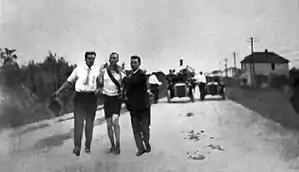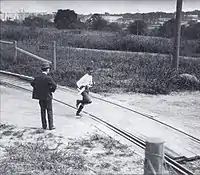Athletics at the 1904 Summer Olympics – Men's marathon
The men's marathon at the 1904 Summer Olympics in St. Louis, United States, took place on August 30 of that year, over a distance of 24.85 miles (39.99 km).[2] Thirty-two athletes representing four nations competed, but only 14 managed to finish the race,[3] which proved to be a bizarre affair due to poor organization and officiating.[4]
| Men's marathon at the Games of the III Olympiad | ||||||||||
|---|---|---|---|---|---|---|---|---|---|---|
 Thomas Hicks and supporters | ||||||||||
| Venue | St. Louis | |||||||||
| Dates | August 30 | |||||||||
| Competitors | 32 from 4 nations | |||||||||
| Winning time | 3:28:53 | |||||||||
| Medalists | ||||||||||
| ||||||||||
| Athletics at the 1904 Summer Olympics | |
|---|---|
| Track events | |
| 60 m | men |
| 100 m | men |
| 200 m | men |
| 400 m | men |
| 800 m | men |
| 1500 m | men |
| 110 m hurdles | men |
| 200 m hurdles | men |
| 400 m hurdles | men |
| 2590 m steeplechase | men |
| 4 mile team race | men |
| Road events | |
| Marathon | men |
| Field events | |
| Long jump | men |
| Triple jump | men |
| High jump | men |
| Pole vault | men |
| Standing long jump | men |
| Standing triple jump | men |
| Standing high jump | men |
| Shot put | men |
| Discus throw | men |
| Hammer throw | men |
| 56 pound weight throw | men |
| Combined events | |
| Triathlon | men |
| All-around | men |

Summary
The first to arrive at the finish line was Fred Lorz, who had actually dropped out of the race after nine miles and hitched a ride back to the stadium in a car, waving at spectators and runners alike during the ride. When the car broke down at the 19th mile, Lorz re-entered the race and jogged across the finish line.[5] After being hailed as the winner, he had his photograph taken with Alice Roosevelt, daughter of then-U.S. President Theodore Roosevelt, and was about to be awarded the gold medal when his subterfuge was revealed. Upon being confronted by officials, Lorz immediately admitted his deception, and despite his claims he was joking, the AAU responded by banning him for a year. He later won the 1905 Boston Marathon.[4][6]
Thomas Hicks ended up the winner of the event, although he was aided by measures that would not have been permitted in later years. Ten miles from the finish, Hicks led the race by a mile and a half, but he had to be restrained from stopping and lying down by his trainers. From then until the end of the race, Hicks received several doses of strychnine (a common rat poison, which stimulates the nervous system in small doses) mixed with brandy.[4] He continued to battle onwards, hallucinating, barely able to walk for most of the course. When he reached the stadium, his support team carried him over the line, holding him in the air while he shuffled his feet as if still running. Hicks had to be carried off the track, and might have died in the stadium had he not been treated by several doctors. He lost eight pounds during the course of the marathon.[7]
Another near-fatality during the event was William Garcia of the United States. He was found lying in the road along the marathon course with severe internal injuries caused by breathing the clouds of dust kicked up by the race officials' cars.[4] Postman Andarín Carvajal joined the marathon, arriving at the last minute.[5] After losing all of his money in New Orleans, Louisiana, he hitchhiked to St. Louis and had to run the event in street clothes that he cut around the legs to make them look like shorts. Not having eaten in 40 hours, he stopped off in an orchard en route to have a snack on some apples, which turned out to be rotten.[5] The rotten apples caused him to have strong stomach cramps and to have to lie down and take a nap. Despite falling ill from the apples and taking a nap, he finished in fourth place.[5][8][9][7]
Arriving without correct documents, Albert Corey, a French immigrant to the United States, is inconsistently listed as performing in a mixed team in the four mile team race (with four undisputed Americans) and performing for the US in the marathon.[6]
Dehydration
The only source of water for the competitors was a well at about the 11-mile mark.[4] James E. Sullivan was a chief organizer of the Olympics, and decided to allow only one water station on the 24.85 mile course of the marathon even though it was conducted in 32 °C (90 °F) heat over unpaved roads choked with dust. His ostensible reason was to conduct research on "purposeful dehydration", even though dehydration is potentially fatal. The marathon ended with the worst ratio of entrants to finishers (14 of 32) and by far the slowest winning time, 3:28:45, almost 30 minutes slower than the second slowest winning time.[5]
Background
This was the third appearance of the event, which is one of 12 athletics events to have been held at every Summer Olympics. Arthur L. Newton of the United States was the only runner from 1900 to return. Other significant American runners included the winners of the past three Boston Marathons: 1902 winner Sammy Mellor, 1903 winner John Lordon, and 1904 winner Michael Spring. Top foreign runners did not come to St. Louis.[10]
Cuba and South Africa each made their first appearance in the event. The United States was the only nation to have runners in each of the first three Olympic marathons.
The marathon included the first two black Africans to compete in the Olympics: two Tswana tribesmen named Len Tau and Jan Mashiani. Len Tau finished ninth and Mashiani came in twelfth. This was a disappointment, as many observers were sure Len Tau could have done better if he had not been chased nearly a mile off course by aggressive dogs.[6]
Competition format
The marathon distance had not yet been standardized; in St. Louis, the course was 24.85 miles (39.99 km). St. Louis organizers started the marathon in the afternoon, while most contemporary marathons start in the early morning to take advantage of cooler times of day. The race began and ended in the stadium, but the rest of the course was on dusty country roads with race officials riding in vehicles ahead of and behind the runners, creating dust clouds.[11][12][13] The start included five laps around the stadium track.[10]
Records
These were the standing world and Olympic records (in hours) prior to the 1904 Summer Olympics. World records and bests were not officially recognized at the time.
| World record | None | None | None | None |
| Olympic record | 2'58:50* | Athens, Greece | 10 April 1896 (NS) |
*Distance was also 40 kilometres
Schedule
| Date | Time | Round |
|---|---|---|
| Tuesday, 30 August 1904 | 15:00 | Final |
Results
References
- Corey was a French immigrant to the United States. The IOC lists him as an American competitor in Marathon, and as a French competitor in the Relay.
- Logman, Jeré (April 20, 2012). "The Marathon's Random Route to Its Length". The New York Times. Retrieved February 3, 2016.
- "Athletics at the 1904 St. Louis Summer Games: Men's Marathon". sports-reference.com. Archived from the original on April 17, 2020. Retrieved July 22, 2017.
- Wallechinsky, David (1984). The Complete Book of the Olympics. New York: Penguin Books. pp. 44–45. ISBN 0140066322.
- Karen Abbott (2012). "The 1904 Olympic Marathon May Have Been The Strangest Ever". Smithsonian Magazine.
- Cronin, Brian (August 10, 2010). "Sports Legend Revealed: A marathon runner nearly died". Los Angeles Times. Los Angeles. Retrieved August 31, 2010.
- Aliya Whiteley (2015). "The Strange Story of the 1904 Olympic Games Marathon". Mentalfloss. Archived from the original on October 11, 2016. Retrieved January 20, 2019.
- Abbott, Karen. "The 1904 Olympic Marathon May Have Been the Strangest Ever". Smithsonian.com. Retrieved April 8, 2015.
- Martin, David E.; Gynn, Roger W. H. (2000). The Olympic Marathon. Human Kinetics. p. 50. ISBN 9780880119696.
- "Marathon, Men". Olympedia. Retrieved August 23, 2020.
- https://www.boredpanda.com/1904-olympic-marathon-st-louis/
- https://www.smithsonianmag.com/history/the-1904-olympic-marathon-may-have-been-the-strangest-ever-14910747/
- https://www.thevintagenews.com/2016/10/28/priority-disastrous-ridiculos-marathon-1904-summer-olympics-2/
Sources
- Wudarski, Pawel (1999). "Wyniki Igrzysk Olimpijskich" (in Polish). Retrieved December 14, 2006.
- Charles J. P. Lucas, The Olympic Games, 1904. St. Louis, Mo: Woodward & Tieran Printing Co., 1905 (copy from LA84 Foundation library)
External links
- Bois, Jon (August 11, 2016). "Rat poison and brandy: The 1904 St. Louis Olympic marathon". SBNation. Retrieved April 23, 2020.